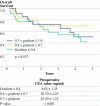Prognostic value of postoperative CEA clearance in rectal cancer patients with high preoperative CEA levels
- PMID: 19657698
- PMCID: PMC2749169
- DOI: 10.1245/s10434-009-0651-x
Prognostic value of postoperative CEA clearance in rectal cancer patients with high preoperative CEA levels
Abstract
Purpose: We determined the prognostic value of carcinoembryonic antigen (CEA) clearance after tumor resection with serial evaluation of postoperative CEA levels in rectal cancer.
Methods: Between 1994 and 2004, we retrospectively reviewed 122 patients with rectal cancer whose serum CEA levels were measured on the preoperative day and postoperative days 7 and 30. Patients with preoperative CEA levels <5.0 ng/ml were excluded. An exponential trend line was drawn using the three CEA values. Patients were categorized into three groups based on R(2) values calculated through trend line, which indicates the correlation coefficient between exponential graph and measured CEA values: exponential decrease group (group 1: 0.9 < R(2) < or = 1.0), nearly exponential decrease group (group 2: 0.5 < R(2) < or = 0.9), and randomized clearance group (group 3: 0.5 < or = R(2)). We then analyzed the CEA clearance pattern as a prognostic indicator.
Results: With a median follow-up of 57 months, the 5-year overall survival was 62.3% vs. 48.1% vs. 25% and the 5-year disease-free survival was 58.6% vs. 52.7% vs. 25% among groups 1, 2, and 3 (P = 0.014, P = 0.027, respectively) in patients with stage III rectal cancer. For those with stage II rectal cancer, the 5-year overall survival rate of group 1 was significantly better than groups 2 and 3 (88.8% vs. 74.1%, respectively, P = 0.021).
Conclusions: The postoperative pattern of CEA clearance is a useful prognostic determinant in patients with rectal cancer. Patients with a randomized pattern of CEA clearance after tumor resection should be regarded as having the possibility of a persistent CEA source and may require consideration of intensive follow-up or adjuvant therapy.
Figures





References
-
- Hutter RV. At last–worldwide agreement on the staging of cancer. Arch Surg. 1987;122:1235–1239. - PubMed
-
- Ahnen DJ, Feigl P, Quan G, et al. Ki-ras mutation and p53 overexpression predict the clinical behavior of colorectal cancer: a Southwest Oncology Group study. Cancer Res. 1998;58:1149–1158. - PubMed
Publication types
MeSH terms
Substances
LinkOut - more resources
Full Text Sources

